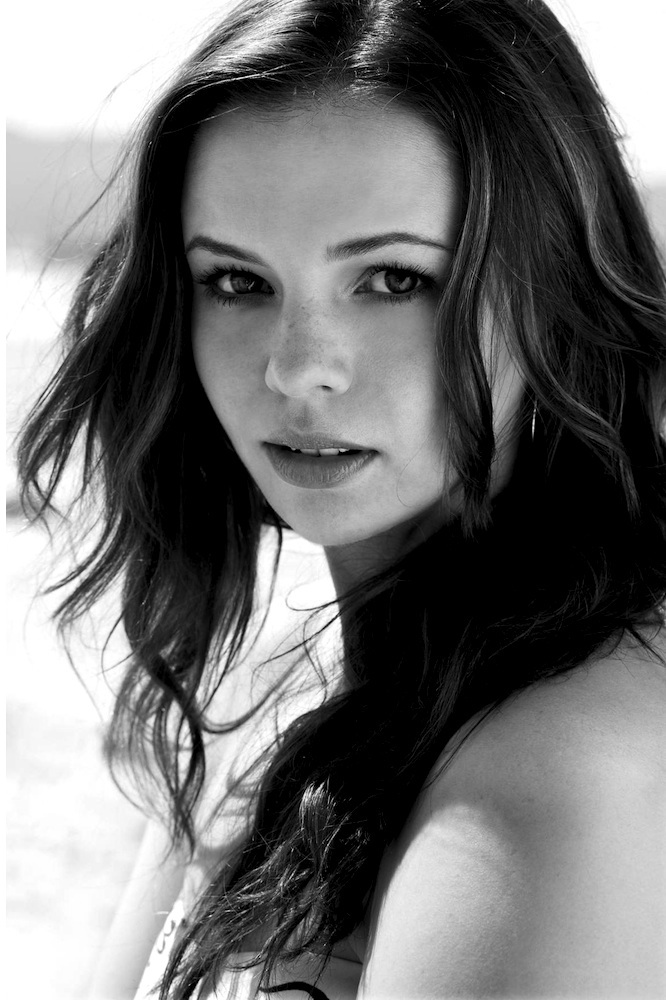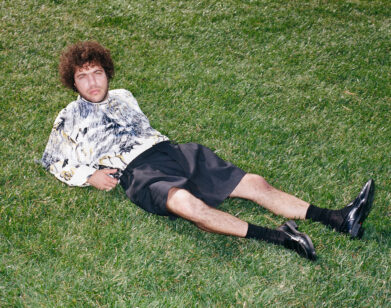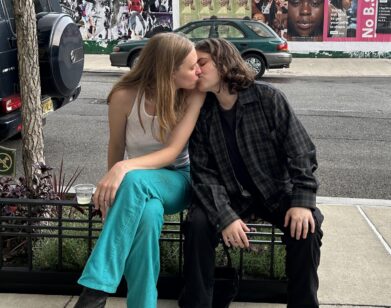The Ghosts of Actresses Past
Dark Sparkler (Harper Perennial), Amber Tamblyn’s third book of poetry, is at once bleak, brutal, and compassionate. Each poem focuses on the final moments of an actress who died before her time, whether it be from murder, illness, accident, or suicide. Some of the names you will recognize: Jean Harlow, Frances Farmer, Carole Landis, Sharon Tate, Brittany Murphy, Jayne Mansfield, and, of course, Marilyn Monroe all have their own pages in the collections. Others—such as Bridgette Anderson, the child star of the 1982 film Savannah Smiles, and Quentin Dean, who appeared in just four films all shot between 1967 and 1968—will lead you down a morbid Google rabbit-hole. Tamblyn uncovers chilling connections between many of her subjects. Nineties porn actress Shannon Michelle Wilsey used the name Savannah as a tribute to Savannah Smiles. Dominique Dunne, the daughter of the late film producer and journalist Dominick Dunne, and Heather O’Rourke starred together in Poltergeist. Although they died decades apart, both Carole Landis’ poem and Anissa Jones’ poem end with the same taught, tongue-twisting verse: “My heart will always be in the right place: / In the caught talk of history’s hingeless jaw / You say Seducing Seconal / I say Seconal the Seducer / At the front line of my ending, / At the bottom of the mountain, / looking down.”
But Dark Sparkler is as much about Tamblyn and America’s toxic culture of celebrity as it is about each of these actresses. The book appeals to and exists because of our morally questionable fascination with the beautiful and the damned, and the self-fulfilling prophecy we’ve attached to the words “child star.” Tamblyn, a third-generation actor and Los Angeles-native who began her professional career at the age of nine, never leaves the frame of her writing. She is present from the second poem (the bitterly funny, mock-casting call “Untitled Actress”), to the epilogue, where she reveals some of the struggles she faced when researching her peers through personal emails.
EMMA BROWN: When did you start writing these poems, and when did you realize it was going to be a collection?
AMBER TAMBLYN: It started with the poem about Brittany Murphy. It was not meant to be a narrative collection in the way that it is, but that piece got so much attention and people really seemed into it. Then two poet friends of mine actually said, “You do realize this is going to be your next book—writing about these women’s lives.” It was really someone else’s idea, not mine.
BROWN: What did you think when they said that?
TAMBLYN: It struck me in the best and the worst sense of the idea. It was one of those things where you go, “Ah, of course that’s the answer!” And “That’s the least easy answer possible.” I knew it was going to be hard. And it was very hard. It took six years to write.
BROWN: I imagine you must have had some interesting dreams while writing this collection.
TAMBLYN: I actually had to take a year off in the middle of it—I think around the third year—just because of how difficult it was. It was really hard. When you’re studying your peers that are dead and they died at the same age that you are, it fucks with your head. The first three years of it, I really enjoyed that sense of letting it get to me, and then after that, it got really difficult, so I took a break from it. I came back and spent about a year and a half finishing it.
BROWN: What was the last poem you wrote?
TAMBLYN: The last poem was the piece that’s in the epilogue about Martha Mansfield, who was a silent movie actress. In 1923, she was doing a film and she was wearing this big hoop skirt—she was a big star, I think she was maybe 20 years old—and the hoop skirt caught on fire, and she burned to death. I did a deconstructed piece—you get to read about me attempting to write a piece like that when I’m exhausted and don’t want to write anymore.
BROWN: Did the poem start out as this deconstruction? Or did you initially set out to write a more conventional poem?
TAMBLYN: I think it started as most of them did: it started not being able to write it, drinking, and trying to figure out if I could write it that way. Trying to find many different ways in which I thought I could write it, and then realizing that the poem is actually about the fact that I can’t write the poem, and letting that unfold. Also just the idea of a wild imagination, and letting that run so that by the end, I’ve sort of placed her inside the poem, inside this true story about going to this party and dancing with Leonardo DiCaprio when I was 14—making her alive again in my teenage imagination. That also happened with one of the last pieces I wrote, which was the Quentin Dean piece. [Quentin] is a very obscure actress that not a lot of people know about. I don’t know very much about her—I interviewed some people, I did all of the homework I could possibly do, and there’s just not a lot of records about her. Some people were saying, “Oh she died, I obtained a death certificate,” or “She quit and she moved to northern California.” There were so many different stories and finally I went, “I’ll go look at the message boards on IMDb, maybe they’ll be something on her page there.” And there were all of these different people saying different things, which kind of cracked me up. That’s where I took that idea for that piece—just a bunch of different people projecting what they thought onto her. Which I also think speaks to the overall idea of the book too.
When I was researching the Martha Mansfield piece, I read this interview with her in The L.A. Times in some old archive I’d gotten from the library. She was talking about how she’d wanted to act since she was a little kid. And I hear that a lot from people, and that to me sounds so crazy, but I guess if you don’t know what the business is like, and you don’t know the heartbreak involved in it, of course you want to do it. But she said she wanted to act since she was 14-years-old. When I was 14, I had already been on General Hospital for three years and I was sad about the fact that I’d missed school and felt alienated from my friends. I also went to a public high school, and there were people that hated me—”You’re that stuck up Hollywood bitch”—and I’d never met them before in my life. [They thought] I was ditching school because I would come whenever I could, but they didn’t have any understanding of what that life was like. So that was very hard for me, and I remember sitting in my parent’s kitchen sobbing and wanting to quit, and my dad talked me out of it. Not in a bad way, but as someone who was a child actor himself, and had been through the business, he really implored me because of the talent. He said, “I’m not telling you to do this for selfish reasons. You’re so naturally good at this and you enjoy it. I know it’s hard, but school would be hard. Anything is hard.” It was a moment in which I was like, “What am I doing? This is not the same thing that everyone else is doing.” It was very alienating.
BROWN: Did you have to consciously make that decision a lot throughout your career? Did you wonder, “Am I doing this because it’s inevitable or am I doing this this because I really want to?”
TAMBLYN: That is another catalyst for this book. Around the time I wrote that Brittany Murphy piece, I was sort of going through my own existential crisis. I was being interviewed for something—for some TV show or movie I’d done—and the interviewer asked me, “When did you know you wanted to be an actress?” I would normally start saying the same story about how it was an accident and I was in a cattle call for General Hospital. And for some reason the question struck me so I hard I couldn’t even answer it. Suddenly realized I had never even really asked myself that: Did I ever had a choice? Did I ever let myself have the choice? I remember, reading an interview with Winona Ryder—I think it was actually in Interview—and I just thought it was so beautiful and elegant and true. She didn’t know that she had permission to do to ask herself, [“Do I want to be an actress?”]. When you do it for so long and [start] so young, you don’t question it. It just is. It’s like going to school. You don’t question any other life but the one you have. That fucks with you once you get into your 20s and 30s, and you start wanting more or finding your own identity. It’s very complicated. I remember reading that and then having that same moment when I was about 27.
BROWN: What about writing poetry? That’s also something you’ve been doing since you were a child. Does that feel more voluntary?
TAMBLYN: Yeah, it’s such a completely different medium and it’s much more personal. The great thing about it is that it’s 100 percent yours—it belongs entirely to you. The story you’re telling, the similes and metaphors within the context of the poem—it’s completely different than me acting where I have absolutely no control over what eventually happens. It has to go through so many forms of things: it has to be edited; it has to be marketed.
BROWN: Acting requires vulnerability, but you also have all these layers between your work and the final product. Did that make it more frightening to put out this really personal collection of poems?
TAMBLYN: I actually think that there are not a lot of layers when you are [acting]. That’s what’s so terrible about it. When you’re an actor, you’re expected to do things that are crazy, that people only do in their bedrooms, that people only do in secret, that people never do in front of other people. You’re just giving that vulnerable moment away—giving it in the hands of the director and so on, which is why nine times out of 10, anything you do never really turns out to what you’d expect it to be.
BROWN: I wanted to talk about Dana Plato’s poem.
TAMBLYN: Dana Plato’s is the most tragic story to me in the whole book.
BROWN: Because of her son?
TAMBLYN: Because of her son. That was actually the last piece I wrote before I took a year off. I made myself listen to the Howard Stern interview that she did, and it’s just the worse thing. As an actress, if I went to bed and had a nightmare after which I woke up in the morning crying and sweating and went to work with black circles under my eyes—a terror nightmare—it would be that experience of going on a show and having people call in and say every terrible thing. Not just, “You’re fat,” or “You’re ugly,” but, “You’re a has-been,” “You’ll never work again,” “You suck.” It was like a joke. In his defense, he tried to stop it a little bit, but she started crying and it was fucking awful. I turned it off and was like, “I’ve got to step back from this. This is officially too much.”
BROWN: One of the pieces I found the most affecting was the one about Lucy Gordon. The first-person narration feels extremely personal and intimate.
TAMBLYN: One of my biggest regrets of this book is leaving my friend’s name out of the acknowledgments who told me this story, who is a really, really dear friend of mine named Gideon Yago. He was the one who had loved her for a very long time. I was finding all this stuff—some of those articles are quoted in the piece—and I texted him and I said, “Hey can we get lunch and can you tell me about Lucy?” He said yes, but he was like, “Let me write it out.” He wrote this long email, and a lot of those things are actually direct quotes of his that I broke up into pieces.
BROWN: It’s so brutal. The bit about her sister wearing Lucy’s clothes as they packed up her apartment made me cry. Was it difficult to approach people—friends or strangers—and ask them to share their first-hand accounts of these tragic events? Like with the Lucy Gordon piece, or even the Fay DeWitt piece, where you include the email inquiry you sent at the end.
TAMBLYN: That was a really spooky experience. That was during writing the epilogue, which I didn’t want to write. My publisher was like, “You have to write something.” He just wanted a poem, and I didn’t want to insert myself into the book anymore than I already was giving voices to the women that were not real. He said, “The most interesting part is your experience writing these poems.” And I knew he was right. I’d read something [about Fay DeWitt] and I looked her up. She’s still alive. You can find very little information but in her 50s, she stabbed her husband to death with a letter opener. He was a playwright. I found there’s website where she’s represented, so I emailed the address, but I also didn’t know yet what kind of piece I would write. She was literally the opposite of any of the people that I had been writing about. She was much older and had killed somebody and had lived through that. I was like, “This might be a really cool, weird, reverse column.” I think I sent the email in the morning and then late that night—I was up in a cabin in upstate New York by myself with my dog—I got that reply. I don’t know if it was an accidental response, but it just was blank. I never heard anything again. When you’re researching ghosts for so long, it was pretty spooky.
BROWN: Some of the people you write about are quite obscure—I had trouble finding them on Google—but you also include some extremely famous actresses like Marilyn Monroe and Jayne Mansfield. Did you feel like you had to include them? Did you every consider leaving them out because they are so famous?
TAMBLYN: No, I felt like everybody needed to be included. The more I could get, the better. And the more I could neutralize people’s ideas about glamour and glamorization of celebrity, and show that underneath everything, all of these women are the same and every woman’s pain is the same.
BROWN: Lindsay Lohan is the only living actress in the collection, and her poem is just a blank page. Why did you include her?
TAMBLYN: Everybody asks me about this. I read it one time in public at a show, and people laughed when I took a big long pause. It was really upsetting to me, and I’ll never read it again because of that. People think that I’m mocking her or sort of saying, “You’re next girl!” which is not at all the case; it’s actually the opposite. It was my way of saying, “Your poem hasn’t been written yet, and I’m not going to write it for you. This page does not belong to anybody but you. You are the carrier of your destiny, and I am not going to do what everyone does to you every day, because I know how that feels. I’m going to give you the page amongst these women.” But I’m in there too. I’ve also inserted myself.
BROWN: Some of the poems come with illustrations by pretty famous people: Kid Koala, Sandro Kopp, etc. How did that come about?
TAMBLYN: Marilyn Mason did the first piece, and that inspired the idea of having different artists who have extremely different aesthetic styles in the artwork that they create. I thought the more diversified, the better it would be and the better it would speak to the individuality of the women in the book. I didn’t want any two to feel alike. I knew Marcel Dzama. I knew Kid Koala. Obviously I knew my dad.
BROWN: Did you choose the poems each artist would illustrate or did they choose them?
TAMBLYN: Some of them did. I actually originally sent David Lynch the Sharon Tate piece. He was really upset by the poem and he didn’t want to do it. He wrote that he didn’t understand why that moment needed to be revisited whatsoever and it was very upsetting for him to read, which for a guy that’s so dark, I was very surprised to hear that.
BROWN: Was that upsetting to hear?
TAMBLYN: No, it was just very, very surprising. But then I realized it could be a generational thing, because he was much closer to that. For him, it might be a much more personal pain. But I knew about his penchant for very visual writing, and I know his art can be like that, so the Laurel Gene piece seemed like the very clear next piece, and that was the one he liked.
DARK SPARKLER IS OUT TODAY, APRIL 7, VIA HARPER PERRENIAL.







